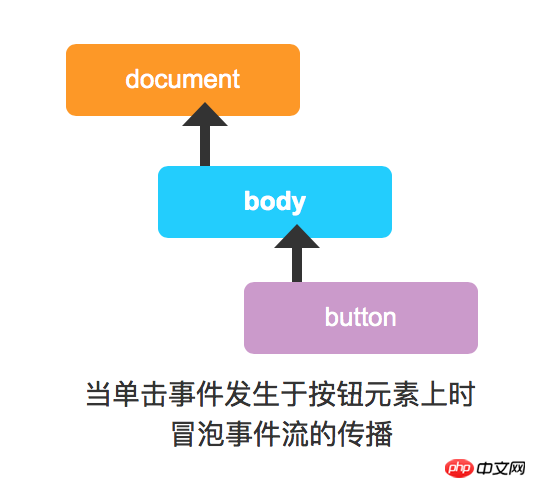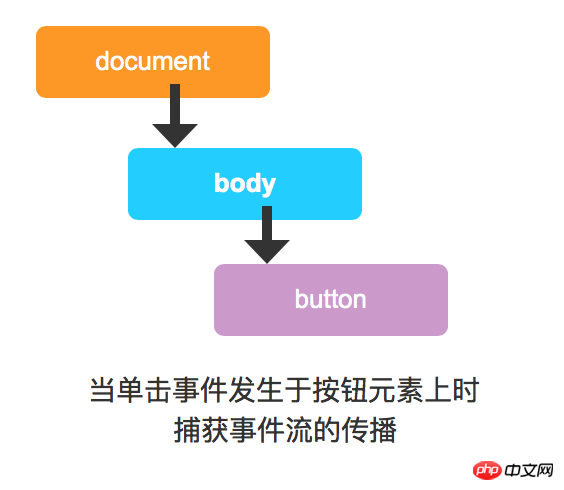
This article mainly introduces the analysis of event bubbling and event capturing of js. It has certain reference value. Now I share it with you. Friends in need can refer to
Contact:
(1)、都是 事件触发时序问题 的术语。 (2)、绑定事件方法(addEventListener)的第三个参数是控制事件触发顺序的,默认为false,即事件冒泡;若为true,即事件捕获。
Difference:
(1)、事件冒泡: 从触发事件的那个节点一直到document,是自下而上的去触发事件。 (2)、事件捕获: 从document到触发事件的那个节点,即自上而下的去触发事件。
(1), bubbling event icon:

<p>
</p><p>事件测试</p>
<script></script>
<script>
window.onload = function () {
//addEventListener绑定事件的第三个参数默认为false
document.getElementById("father").addEventListener("click", function () {
console.log("这是父亲=>" + this.id)
});
//addEventListener绑定事件的第三个参数默认为false
document.getElementById("son").addEventListener("click", function () {
console.log("这是儿子=>" + this.id)
})
}
</script>
//结果:
点击father输出结果: 这是父亲=>father
点击son输出结果: 这是儿子=>son 这是父亲=>father (事件冒泡:先son,后father)(2) , the event bubbling mechanism used in the above code:
1. When the son element is clicked, the click event of son is triggered first, and then the click event of father is triggered, and the corresponding content is printed;
2. When the father element is clicked , only triggers the father's click event, because the father element bubbles up and there is no dom element to set the click event function
(3), prevent the event from bubbling
e.stopPropagation();
Event capture icon:

<p>
</p><p></p>
<script></script>
<script>
window.onload = function () {
//addEventListener绑定事件的第三个参数默认为true
document.getElementById("father").addEventListener("click", function () {
console.log("这是父亲=>" + this.id)
},true);
//addEventListener绑定事件的第三个参数默认为true
document.getElementById("son").addEventListener("click", function () {
console.log("这是儿子=>" + this.id)
},true)
}
</script>
//结果:
点击father输出结果: 这是父亲=>father
点击son输出结果: 这是父亲=>father 这是儿子=>son (事件捕获:先father,后son)The above code uses an event capture mechanism:
1. When the son element is clicked, the father's click event is first triggered. Then trigger the son's click event and print the corresponding content;
2. When the father element is clicked, only the father's click event is triggered, because the father element is captured from above until the father element has no dom element and the function of the click event is set ;
(1),Definition
事件委托:利用事件冒泡的原理。
(2),Usage: When there is When multiple similar elements need to bind events, binding them one by one is a waste of time and is not good for performance. At this time, you can use event delegation to add an event function to one of their common parent elements to handle them
For all event situations, the code is as follows:
Note: The hover event cannot use event delegation.
(3), Although the above example does not add a click event to li, why clicking the corresponding li will have an effect, we can understand: Although we do not set a click event for li, However, the default click event uses time bubbling. The click event that bubbles to the parent
level element uses the target attribute of the event to determine the clicked element
e.target Represents the source element that triggered the event in the event bubbling.
And e.target has many attributes that can be manipulated:
- e.target.nodeName //获取事件触发元素标签的name - e.target.id //获取事件触发元素的id - e.target.className //获取事件触发元素的className - e.target.innerHTML //获取事件触发元素的内容
The above is the entire content of this article, I hope it will be helpful to everyone's study , please pay attention to the PHP Chinese website for more related content!
Related recommendations:
Explanation of tips for Array arrays in JavaScript
How to use JS to implement a simple digital clock
How to implement a stack in JavaScript
The above is the detailed content of Analysis of js event bubbling and event capture. For more information, please follow other related articles on the PHP Chinese website!




